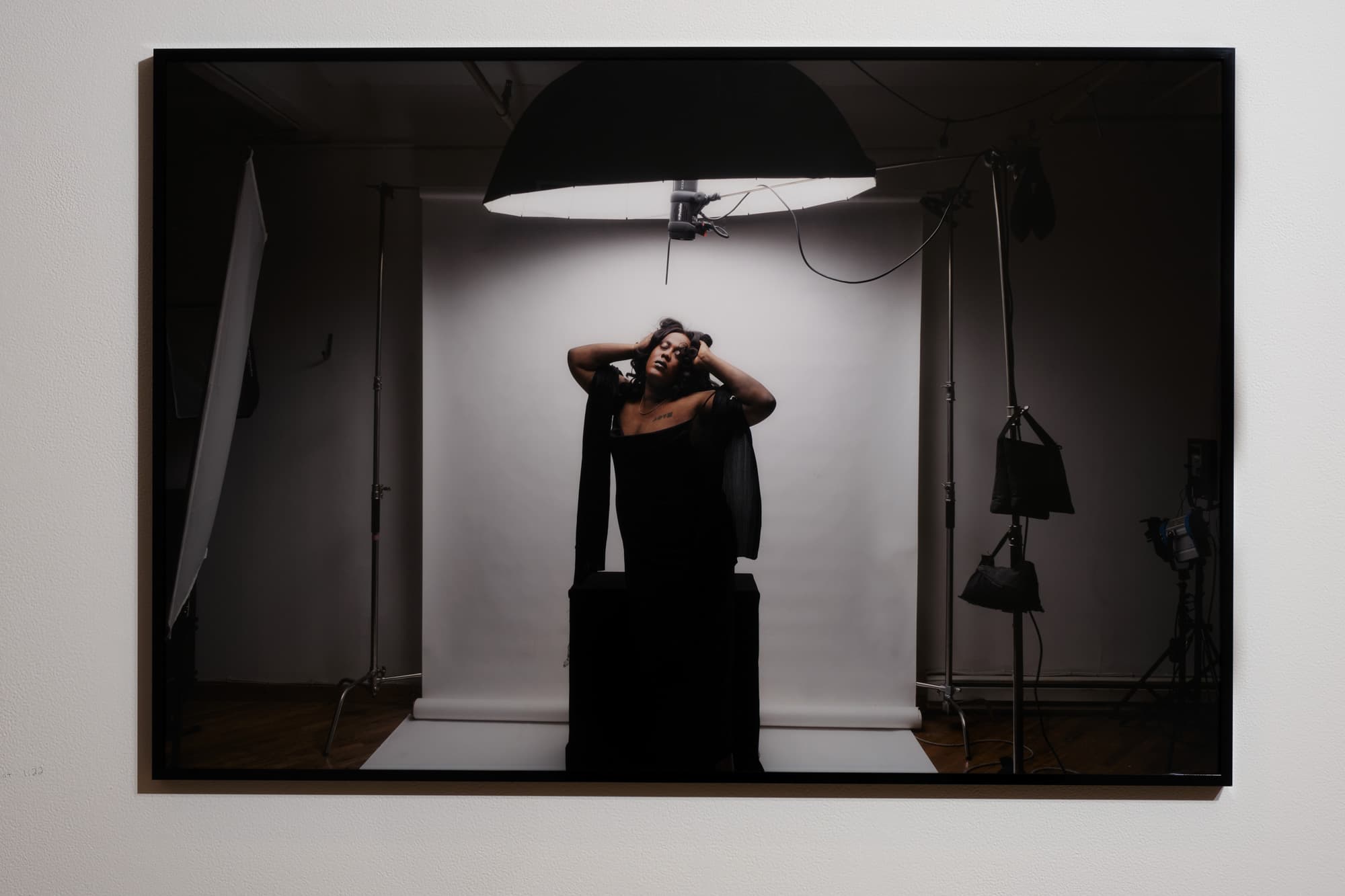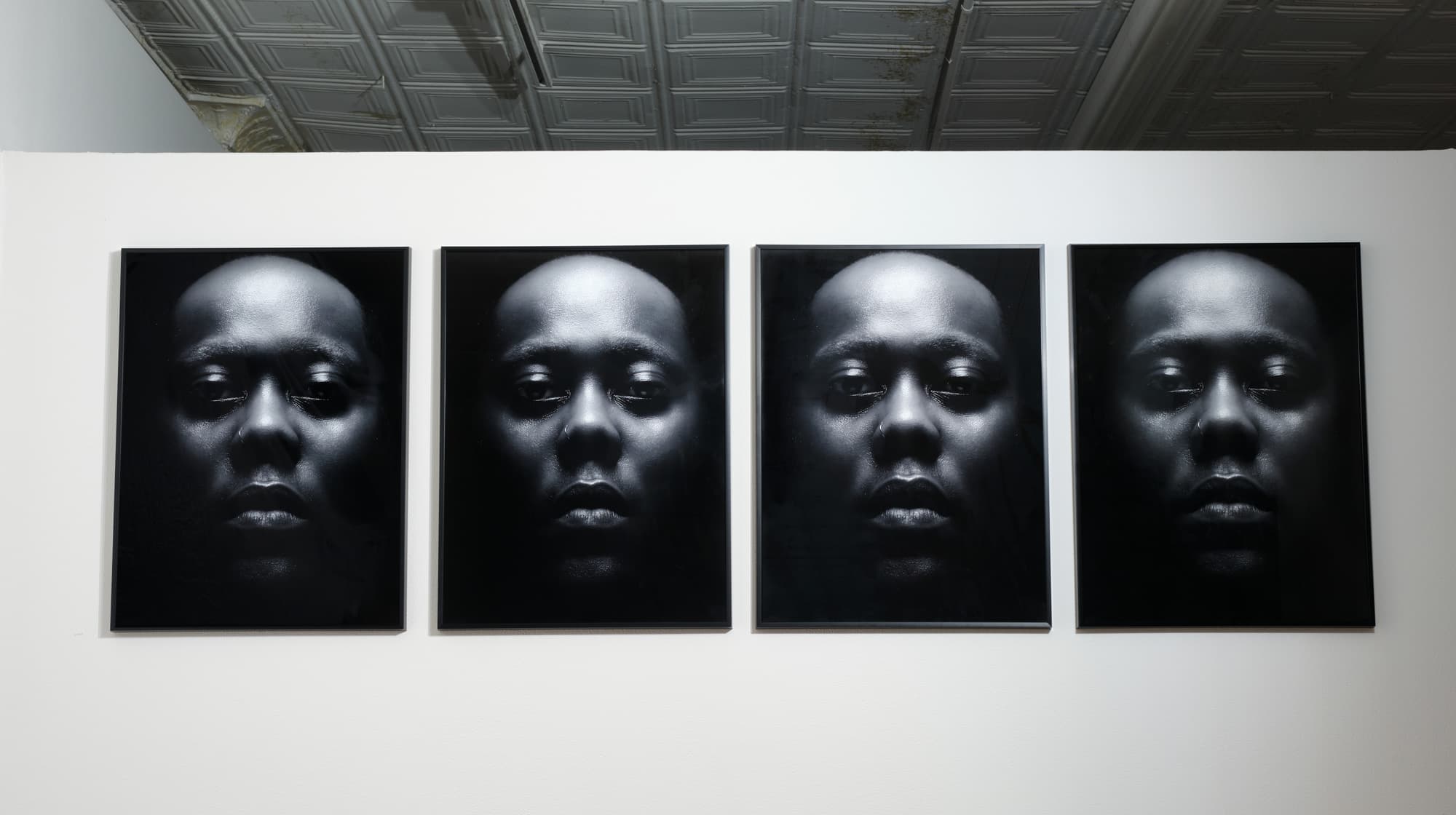Published October 2, 2023
Darryl DeAngelo Terrell Asks to be Loved as Both Soft and Strong

In thirteen images, multi-disciplinary artist Darryl DeAngelo Terrell builds a love letter to their queer, trans, nonbinary, Black body. Presented by Baxter St at the Camera Club of New York, It’s Never Too Late to Tell Me You Love Me is Terrell’s first solo show in New York City. In this work, Terrell spins together an exploration of self-love that recognizes the tension between their softness and strength.
The exhibition is comprised of staged self-portraits as their feminine alter-ego, Dion. It’s through their self-presentation as Dion that Terrell finds joy and comfort expressing glamor, femininity, and poise. In this series, Terrell is putting a vulnerable request on the line: they ask to be loved as the whole person presented in the images, someone who is both beautiful and soft while retaining strength and self-worth.
“In order for me to understand how I want to be treated gently,” says Terrell, “I have to learn how to teach people to do that. That’s a level of labor that I have to automatically endure when engaging with people, whether it be platonically, sexually, or familial.”
A tension between strength and softness is evident throughout their self-portraiture in this exhibition and in the way they describe their relationship to others, queerness, and to their body.
“I wanted to introduce a level of softness to this body,” says Terrell. “Through Dion I explore sexuality, sensuality, desire, and bodily autonomy for a fat, Black, queer, nonbinary body. A body that is othered; a body that holds a lot of history and a lot of weight to it, both literally and physically.”
The works on display in this exhibition were created during their time as a Baxter St resident earlier this year, with a few supporting works made during residencies at Black Rock Senegal and Fire Island, respectively. These three distinct eras offered Terrell different opportunities to understand their own queerness and how others interact with that identity.
While in Senegal, a country where same-sex activity is criminalized, Terrell found it difficult to express queerness anywhere outside of their small apartment. Though they had initially planned to make work in more public spaces, Terrell realized upon arriving at the residency that they would need to pivot their approach. The image Terrell chose to include in It’s Never Too Late from this body of work is a small and intimate close-up on their face as they sit in a bathtub, and acts as a meditation on longing for love and acceptance.
On Fire Island, however, Terrell’s body was objectified by others in a largely queer community. The interactions they had with other queer people on the island led them to consider how their body presented in spaces that are tied heavily to queer desire.
“I’ve never felt so invisible but visible in this body,” says Terrell. “Being on Fire Island, if I saw a Black person, they may have been the token Black person amongst a group of white gays. People would walk past me and ignore me, but then it would be older white granddaddies that would hit on me in a pervasive way.”
Through Dion I explore sexuality, sensuality, desire, and bodily autonomy for a fat, Black, queer, nonbinary body. A body that is othered; a body that holds a lot of history and a lot of weight to it, both literally and physically.
The time Terrell spent making this work for the Baxter St residency was quite different from those previous experiences. The flexibility allowed by the Baxter St residency gave them time to travel home to Detroit, where they made intimate self portraits in their mother’s back yard, two with their mother in frame and one with Dion as the sole subject. In New York, they were also able to explore working at a studio in DUMBO owned by a Black transfemme, and composed entirely of Black and queer members.
In this studio space, Terrell made two series of works included in It’s Never Too Late. The first is a diptych of Dion in the studio. Our vantage point as the audience is pulled back, allowing us to see the lighting umbrella and full studio set-up. A traditional studio image is polished and presented out of its context of creation. Here, Terrell does the opposite and invites the viewer to see behind the curtain in their process of posing and lighting Dion.
Diagonally across from this diptych is a series of four images hung at Terrell’s height. The viewer must physically look up to meet Terrell’s gaze. The four images look identical at first glance, but upon closer inspection, small differences become apparent to the viewer. These slight alterations, Terrell notes, are digital manipulations to their physical appearance. The first image in the set is untouched, while the other three bring Terrell’s physical features in alignment with specific beauty standards.

It is in these studio portraits that Terrell’s strength shines through. Their presentation is beautiful and soft, but presented in combination with the images from Senegal, Fire Island, and Detroit, we see how much work Terrell has done to get here. They have allowed themself to be soft, vulnerable, and imperfect in pursuit of their own beauty and self-love.
“Sometimes I truly just want to feel pretty,” says Terrell, “in a world that doesn’t allow me to feel pretty.”
While making this work, Terrell knew there was a narrative to be told about Dion, their body, and the intimacy they seek and crave from other people. The culmination of this narrative is in the second-to-last image in the exhibition. Terrell as Dion addresses the gaze of the camera head-on, at home in their power and poise as a beautiful person worthy of admiration and love.
Testudo is always looking for more voices to write with us about the art world. If you’d like to pitch an article, please see our pitch guide for more information!



